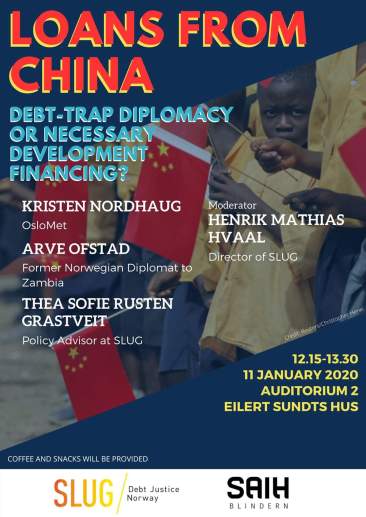Today we have a seminar debate at Oslo University, the title is “Loans from China: Debt-trap diplomacy or necessary development financing?” Many think China’s loans, which might have debt-trap for poor countries. Most of the Chinese loans are providing to former countries the stronghold of western countries for several decades. But China succeeds to take over the position of western countries’ playground through her “BRI (Belt Road Initiatives) and OBOR (One Belt One Road)”.

My presentation at the seminar is such as below:
Before we continue our main topic discussion, I would like to present short to the points of China’s BRI and OBOR. We really need to see China’s loans by doing research on the background of OBOR (new era Silk Road) in order to understand correctly.
Ever since being elected as the General Secretary of the Communist Party of China (CPC) in November 2012 and subsequently the President of China in March 2013, Xi Jinping has put forth grandiose ideas like the “Chinese Dream”, the “Belt and Road Initiative (BRI), or the “One Belt One Road” (OBOR), the literal translation of yidai yilu.
The former aims to “realize the great rejuvenation of the Chinese nation”, by realizing the two centenary goals, i.e., to double the 2010 GDP per-capita income and build a moderately prosperous society by 2021 when the Communist Party of China marks its 100th anniversary; and second goal is to turn China into an all-around modern and socially advanced country by 2049 when the People’s Republic marks its centenary. The BRI refers to setting up of a geopolitical and geo-economic Silk Road Economic Belt (SREB) and the 21st Century Maritime Silk Road (MSR) connecting China to Africa and Europe by land and sea.
The grandiose initiatives, especially the BRI, have raised hopes as well as suspicious to what China is up to, and that, even if silk routes existed in ancient times, what is the relevance of such initiatives in modern times? Also, whether such initiatives are in sync with China’s foreign-policy goals, such as multi-polarity, not seeking hegemony, common security, etc., or an antidote to the US foreign-policy goals like ”pivot to Asia” or “Trans-Pacific Partnership” (TPP), albeit the context may change as Donald Trump abrogated the TPP immediately after assuming the office. Or, is China challenging the US hegemony and rewriting the rules of global political and economic order?
These are some of the questions which have been debated ever since the idea was floated, and more specifically, since May 2017, when China convened the Belt and Road Forum in Beijing, attended by 1,500 delegates from across the world and which had 29 heads of the states and officials, entrepreneurs, financiers, academicians and journalists from over 130 countries, including figures such as Vladimir Putin, UN Secretary-General Antonio Guterres, World Bank President Jim Yong Kim, and Managing Director of the International Monetary Fund Christine Lagarde, etc.
In order to bulldoze the $ 1.4 trillion “project of the century”, Xi Jiping pledged $ 14.49 billion more to the existing $ 40 billion Silk Road Fund founded in late 2014. The Development Bank of China and the Export-Import Bank of China pledged to inject $ 124 billion into the Belt and Road Initiative to support infrastructure, financing, and industrial capacity (Deepak 2017a)1.
On the occasion, China also signed 76 megaprojects with Belt and Road countries, signed trade cooperation deals with 30 countries, and signed agreements related to unimpeded trade with 60 countries. What exactly is the BRI? Why all China has initiated this strategy? Furthermore, the geographical boundary of the BRI was further extended to Latin America, thus bringing the entire globe into the ambit of the New Silk Road.
Well, the concept was first proposed by Xi Jinping during a speech at Nazarbayev University, Kazakhstan, on 7 September 2013 when he said that “To forge closer economic ties, deepen cooperation and expand development in the Euro-Asia region, we should take an innovative approach and jointly build an “economic belt” along the silk road. This will be a great undertaking benefitting the people of all countries along the route. Xi (2014) proposed that traffic connectivity needs to be improved so as to open the strategic regional thoroughfare from the Pacific Ocean to the Baltic Sea and gradually move toward creating a network of transportation that connects Eastern, Western, and Southern Asia.
The Chinese president also urged the regional members to promote local currency settlement so as to improve their immunity to financial risks and their global competitiveness. In October, he visited Indonesia and floated the idea of building a twenty-first-century MSR with the aim to deepen China’s economic and maritime links with the MSR countries and regions. The MSR begins in Fuzhou’s Quanzhou in southeast China’s Fujian province and extends south into the ASEAN nations, crosses the Malacca Strait, and turns west to countries along the Indian Ocean before meeting the land-based Silk Road in Venice via the Red Sea and the Mediterranean. Under the ambit of MSR, China plans to build hard and soft infrastructure from Indo-Pacific to Africa, including transport, energy, water management, communication, earth monitoring, economic, and social infrastructure.
The important facts of Loans: Loans provider and Loans receiver countries:
Investment is necessary for all-round development of any country. Both loans provider and receiver are responsible for the risks. When China’s loans were given, both governments have to agree on terms and regulations before the agreement has done. Both governments’ representatives or officials have studied carefully advantages and disadvantages not to be harmful to each side. Therefore, we cannot simply conclude as China’s loans are intended to be “Debt-trap diplomacy”. Instead, I prefer to call “Open Economics Strategy competition between Loans provider and receiver”.
Every countries’ foreign policies were to be beneficial for own country; in the meantime prefer to pay attention to a win-win strategy which is common to practice. Most African countries and poor countries have taken loans more than nations are capable to pay back on time. Loans provider oversaw the nature of the loan receiver’s capability and weakness. If needed Loans provider will be using any means diplomacy to “debt-trap”, but it is the receiver’s foolishness to take to loans more than her own capacity to pay back on time. (For example 1; Sri Lanka has taken more loans in terms of military hardware to wipe Tamil tigers insurgent (LTTE, during May 2008) and infrastructure development from China, which results in Magampura Port ownership will be taken over by China for 99 years as a lease.
Example 2: A similar project has been implemented in Pakistan’s Gwadar Port, which has also worrisome by the locals.
Example3: Myanmar’s Shwe gas pipeline and Kyaukphyu deep sea port could mean a loan trap too. )
China’s loans providing itself is not a problem, but the problem is when China provides loans to the government which has no concern about the wills of its people; or when the country is ruled by authoritarian leaders. In that case, the loans will not be productive for the country as it should be; most of them will disappear in the hands of corrupt officials. Therefore, China must be aware of that, their loans could be a loss one, once those authoritarians were gone by the movement of people power. If not, those china’s loans will be remained as “debt-trap” for the receiver country.
Poor countries will more and more need Loans in order to upgrade infrastructure and modernization. Without external loans, most poor countries will never able to break out “vicious circle of poverty”. As a result of the country’s high demands to take external loans, poor countries have to pay back loans through the below market value of natural resources. China’s loans interest rates are higher than World Bank, International Monetary Bank, and others; the restriction on taking China’s loans is too easy compared to others, which motivated poor countries to be closer to China’s loans.
Roles of International communities and discussion among attendees
Here my question is: How the western countries / international communities can play counterbalance against China’s loan influence over poor countries?
To be continue….
Filed under: 3 World News |






Leave a comment